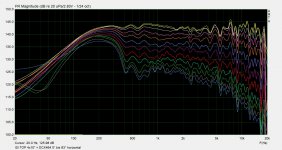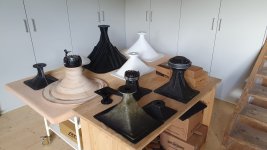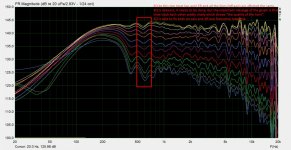isitone, Very nice! did you turn it manually with some jig/template? I mean it is pretty accurate work, the measurements are really good.
May I ask how many hours of work went into it and how much experience is needed to achieve such piece? One of my relatives has suitable lathe but I don't have very high hopes turning one yet since I don't have experience and the owner is not into audio nor precision 😀 It could be nice if you gave a quick summary what it takes to turn such horn at home? Thanks!
May I ask how many hours of work went into it and how much experience is needed to achieve such piece? One of my relatives has suitable lathe but I don't have very high hopes turning one yet since I don't have experience and the owner is not into audio nor precision 😀 It could be nice if you gave a quick summary what it takes to turn such horn at home? Thanks!
Last edited:
We need to see the impulse response to determine what the issue is. Measure at as low a level to the transducer that you can get away with, i.e. not so low that noise becomes an issue. Set mic gains etc. such that the signal that you get from the mic is nearly as large as possible. This might take some practice.
Do I do this from the same distance as before, which was about 1 meter from throat.
Do I do this from the same distance as before, which was about 1 meter from throat.
Yes. But I would typically prefer to see 1.5 m from the mouth, but that may not be possible in your setup.
I don't want to talk about the types and models of the other brands. The picture shows a part of the selection, this must be enough information.
View attachment 953821
You've got lots of familiar horns there. I spot (2x?) B&C, RCF, SEOS, E-V / JBL-type diffraction horns (or R-H / Community clones) and the asymmetrical Limmer (021?).
I endorse your findings. While some smooth diffraction horns can sound really good when crossed high (the small RCFs, for example), I prefer a bigger horn without slot for crossover points around or below 1000 Hz.
Last edited:
isitone, measurements, are they EQed? (I guess not...)
When you say "marcel's design" is it a specific one (big sand horn?) or one that was made with the ATH software (your design)?
//
When you say "marcel's design" is it a specific one (big sand horn?) or one that was made with the ATH software (your design)?
//
TNT, Image with thousand words 😀
EQ is not relevant to see the waveguide "quality" behind the graph isitone posted. You can use any EQ and as much as you want with horn like this. Do a FIR filter with the listening axis signal and the response fixed on all axis (because the frequency response is mostly the same on all measured axis) which means there is no acoustical problems with the waveguide = as good as it gets. This particular waveguide however shows some narrowing around 1.5kHz which some of Marcel designs don't have. Still not nearly as much problems as most commercial horns available to purchase. Wanted to post it here since for example turk182 continuously questions "the quality", I thought maybe people don't understand what they are looking at in the graphs?
EQ is not relevant to see the waveguide "quality" behind the graph isitone posted. You can use any EQ and as much as you want with horn like this. Do a FIR filter with the listening axis signal and the response fixed on all axis (because the frequency response is mostly the same on all measured axis) which means there is no acoustical problems with the waveguide = as good as it gets. This particular waveguide however shows some narrowing around 1.5kHz which some of Marcel designs don't have. Still not nearly as much problems as most commercial horns available to purchase. Wanted to post it here since for example turk182 continuously questions "the quality", I thought maybe people don't understand what they are looking at in the graphs?
Attachments
Last edited:
Sure 🙂 I just wanted to understand if it was applied or not in this particular measurement. My view is still, except FIR et al., that the naturally smoother, the better i.e. I welcome local higher Q dips and peaks to be absent. Broader variations are none malign. I do understand that all angels follow EQ.
//
//
Sure 😀 One more sentence for anybody still wondering what the heck. The dips and peaks that appear in all axis are problems of the driver, not the horn and can be EQ:d out. Use smooth driver and the response is smooth without EQ. If the lines were not tracking each other they would indicate acoustic problem in the horn which can't be fixed with EQ. Cheers 🙂
Last edited:
I made these profiles for isitone, which is a specific use with somewhat constrained mouth roundovers. I'm actually quite pleased with the results, given the constraints.
Last edited:
I'm not sure I understand what you mean. I can't see any narrowing around 1.5k.tmuikku said:... This particular waveguide however shows some narrowing around 1.5kHz
^ hah yeah the lines seem to pinch a bit closer together there at 1-2kHz than below or above that. It is actually widening response (not narrowing) but the edit time was over when noticed the error.
Last edited:
... the cancellation of reflections at LFs which, when done, will allow for very accurate measurements in virtually any space.
I have been very interested in the theory of the Klippel Near Field Scanner ever since I became aware of it some time back.
You may remember we discussed this in the "DIY Klippel" thread.
What improvements will your work offer over the way the NFS does this?
Best wishes
David
Last edited:
What improvements will your work offer over the way the NFS does this?
Performance wise, I doubt that there will be any improvement - they are basically both the same approach.
My interest is in simplifying the technique to be useful for DIY (who can't afford the 100k$+ that a Klippel costs.)
Remember this was a coaxial compression driver. This is about as good as it gets for that kind of device. The good thing is that there are no vertical lobes above the lower xover point - what you see is basically the complete behaviour of the loudspeaker in that band.... My view is still, except FIR et al., that the naturally smoother, the better i.e. I welcome local higher Q dips and peaks to be absent. Broader variations are none malign. I do understand that all angels follow EQ.
//
The dips and peaks that appear in all axis are problems of the driver, not the horn and can be EQ:d out. Use smooth driver and the response is smooth without EQ. If the lines were not tracking each other they would indicate acoustic problem in the horn which can't be fixed with EQ. Cheers 🙂
I don't believe that this is correct.
If there is a reflection at the mouth that causes a standing wave inside of the device, then these resonances will be as constant throughout the sound field as a resonance in the driver itself.
^ hmm I had impression the mouth reflections would not make all directions the same, but I'm no expert. Doesn't this mean such reflections would be correctible with a FIR filter? They would appear in the ABEC simulations?
Last edited:
They would be correctable with an FIR filter and globally as long as the waveguide itself exhibits constant directivity. Basically devices that can be corrected globally tend to not have internal reflections.
- Home
- Loudspeakers
- Multi-Way
- Acoustic Horn Design – The Easy Way (Ath4)




